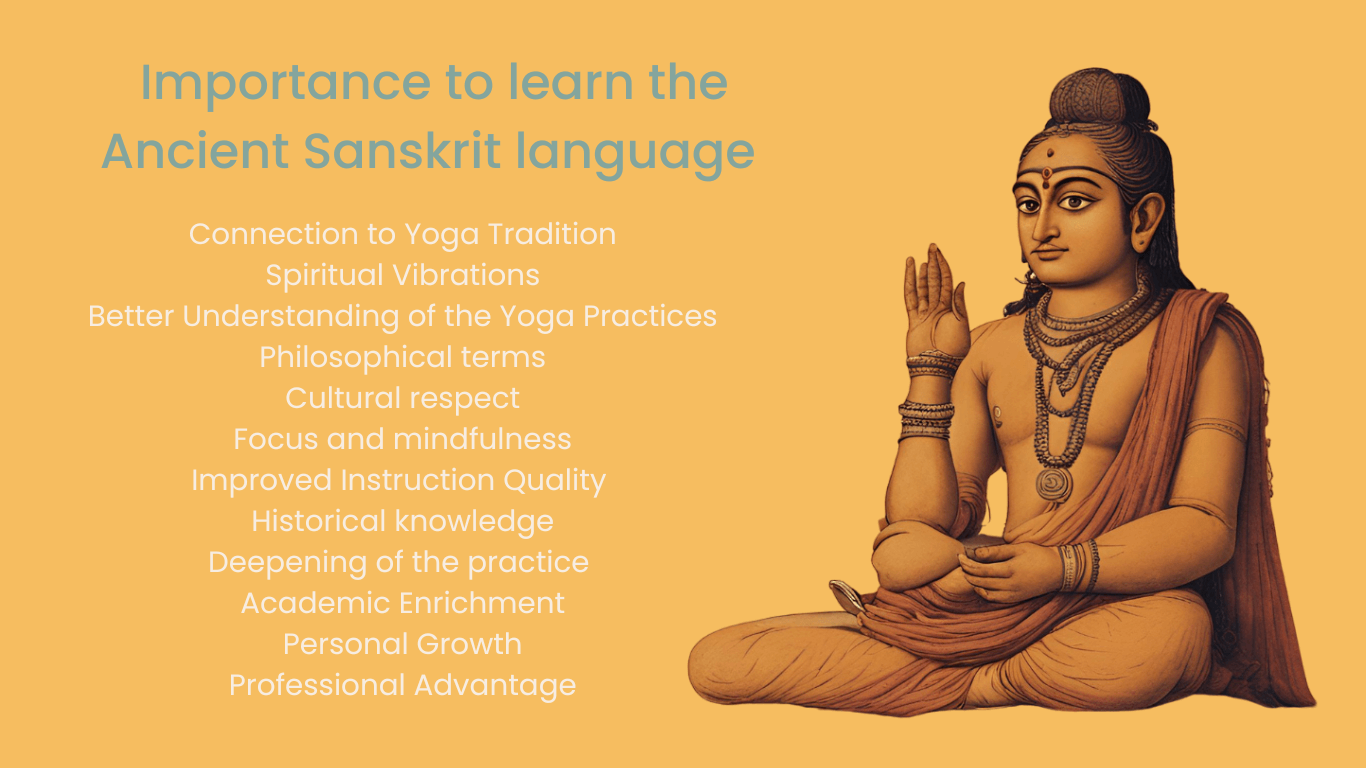Learn the Ancient Sanskrit language or terminology as a Yoga Teacher
Connection to Yoga Tradition
Sanskrit is the original language of many foundational Yoga texts like the Vedas, Hatha Yoga Pradipika, Patanjali Yoga Sutra, The Bhagavad Gita, Gheranda Samitha, The Upanishads and many other scriptures.
Learning Sanskrit in Yoga allows practitioners to connect directly with these ancient texts and their teachings. Learning the Sanskrit language helps to preserve the authenticity of their practice.
Spiritual Vibrations
-
This Ancient Sanskrit language is known and popular for its vibrational qualities; chants in Sanskrit create different vibrations in the body and release unique frequencies from the body parts, promoting healing and bringing a calming effect on the body and mind.
-
Relaxation of body and mind lead to spiritual enhancement.
Yoga Sanskrit – Get a Better Understanding of the Yoga Practices
Learning and using Sanskrit terminology helps in better understanding of the Yoga concepts; just take the word Yoga as an example.
What does Yoga mean in Sanskrit? The word "yoga" is derived from the Sanskrit root "yuj," which means "to yoke," "to join," or "to unite. Understanding Sanskrit helps to connect with the true meaning of the terms used in the Yoga practice. It allows deepening the practice and to grasp philosophical concepts more easily, such Atma (Soul), Moksha (Liberation), Dharana (Concentration), Dhyana (Meditation) and many more Sanskrit terms.
Philosophical terms
Yoga is not just a physical practice but it is a spiritual and philosophical practice first. Physical practice is a small part of Yoga. It helps to keep the body strong, flexible and healthy so Yogis can follow their Yoga Sadhana without any physical suffering.
Sanskrit terms encapsulate complex concepts that often get lost in translation like the difference between Dharana and Dhyana.
Ask yourself, do you know the difference between them?
Learning and knowing Sanskrit terms can enrich your philosophical understanding of Yoga, which brings the practice to a subtler and deeper level.
Cultural respect
Learning and using Sanskrit terms shows respect to the historical and cultural roots of Yoga. Using the Sanskrit terms during the practice of Yoga honors its traditions and the people from where the practice originates – India.
Focus and mindfulness
To learn and practice Sanskrit for Yoga requires concentration and mindfulness that can enhance the Yoga practitioner’s qualities like focus and awareness.
This can make their practice more focused, effective and meditative.
Consistent Terminology
Sanskrit is a universal language of Yoga, whether someone practice Yoga in India, Europe, USA, or any other part of the world, Sanskrit terms remain the same, which creates consistency, understanding and a feeling of a global community.
Improved Instruction Quality
Precise Terminology: Sanskrit terms for yoga postures (asanas) and practices are very specific and have precise meanings. Using these terms helps ensure accurate communication of the intended postures and practices.
Consistency: Sanskrit names for poses are universally recognized in the yoga community, allowing for consistent instruction across different teachers and styles of yoga. This consistency helps students learn and remember the poses more easily.
Rich Descriptions: Many Sanskrit terms are descriptive and convey deeper meanings or visualizations, aiding in better understanding and execution of the poses. For example, "Adho Mukha Svanasana" literally translates to "downward-facing dog pose," providing a clear image of the posture.
Historical knowledge
Ancient Sanskrit language gives insights into the historical context of Yoga. Understanding of Sanskrit can help Yoga practitioners to appreciate the evolution of Yoga. By studying texts in their original Sanskrit, one can trace the chronological development of yoga practices and philosophies. This helps understand how yoga evolved from the Vedic, pre-classical, classical, post-classical, and modern time periods. It also creates an understanding of different spiritual traditions and how they influenced each other.
Deepening of the practice – Sanskrit Yoga
Sanskrit learning allows Yoga practitioner to delve deeper into their practices and take it into the advanced Yoga practices such as Mantra Chanting, Pranayama, Pratyahara, Dharana and Dhyana practices. Many mantras and chants used in Yoga are in Sanskrit. Knowing the language allows practitioners to understand and feel the full vibrational and spiritual effects of these recitations.
Academic Enrichment
Yoga Teachers and practitioner who are interested in deepening their studies by enrolling in a bachelor or master degree at a university have to know Sanskrit.
Apart from that it enables a more profound exploration of ancient scriptures like Patanjali Yoga Sutras or the Bhagavad Gita. It can also make it easier to understand the yogic practices explained in the Hatha Yoga scriptures, like the Hatha Yoga Pradipika.
Personal Growth
As a Yoga teacher or Yoga practitioner you already know that learning and practicing Yoga is nothing short term, it is a lifelong process. Learning Sanskrit can be intellectually stimulating, and personally rewarding and a next step to deepening Yoga knowledge.
Professional Advantage
Sanskrit provides a professional advantage by enhancing teaching credibility, ensuring accurate instruction, connecting to yoga’s traditions, enabling global communication, offering direct access to primary texts, and enriching the spiritual aspects of yoga practice. This proficiency sets you apart in the field, making you a more knowledgeable and respected Yoga instructor.
The Importance of Introducing Sanskrit in Yoga Teacher Trainings
Introducing Sanskrit and basic terms in our 200 hour Yoga Teacher Training enhances the learning experience by connecting students to the rich historical and philosophical roots of Yoga. Understanding Sanskrit terminology fosters a deeper comprehension of the poses, practices, and principles central to yoga, ensuring that our future instructors can communicate these concepts with accuracy and authenticity.
Curriculum Highlights
Foundational Terminology: In our 200hr Yoga teacher training we will cover the essential Sanskrit terms used in Yoga, including the names of asana (postures), pranayama (breathing techniques), and meditation practices. This foundation ensures that students can confidently use and understand these terms in their teaching and personal practice.
Historical Context: By learning Sanskrit, students gain direct access to key Yoga texts such as the Yoga Sutras of Patanjali. We will explore select verses in their original language to understand the philosophical and spiritual insights they offer.
Cultural Connection: Sanskrit is more than just a language; it is a bridge to the culture and traditions from which Yoga emerged. We will delve into the etymology of key terms and their cultural significance, increasing students’ appreciation of Yoga’s origins and its evolution.
Practical Application: Instructors will demonstrate how to effectively incorporate Sanskrit into class instructions, enhancing clarity and consistency. Students will practice using Sanskrit in teaching scenarios to build confidence and fluency.
By integrating Sanskrit into our Yoga Teacher Training programs, we aim to provide a holistic and comprehensive education that honors the traditions of yoga while preparing our students to be knowledgeable and effective instructors. This approach ensures that the essence of yoga is preserved and transmitted with integrity and respect.
Conclusion
Cultural Appreciation: Being open to learning and using Sanskrit terms honors and respects the traditions of Yoga from where it originates.
Cultural and Historical Connection: Learning Sanskrit terms connect students to the ancient roots and traditions of yoga, providing a richer and more authentic experience.
Mindfulness and Focus: Knowing the Sanskrit names of poses can make it easier for students to follow along in classes and understand the progression of the practice and being focused on their own movements.
Enhanced Understanding: Sanskrit terms often encapsulate the essence of the pose, including its physical form, energetic qualities, and symbolic significance. Understanding these terms can deepen the comprehension and engagement with the practice.
Global Language of Yoga: Since Sanskrit is the classical language of Yoga, knowing these terms allows you to practice and communicate with yogis from around the world. This can be particularly beneficial for those who travel or participate in international Yoga workshops and retreats.
Pronunciation and Intonation: Proper pronunciation and intonation of Sanskrit words can have a vibrational effect that enhances the energetic experience of the practice.
Integration of Philosophy: Sanskrit is also the language of many foundational yoga texts. Familiarity with Sanskrit can help students engage more deeply with these texts and the philosophical aspects of yoga.


